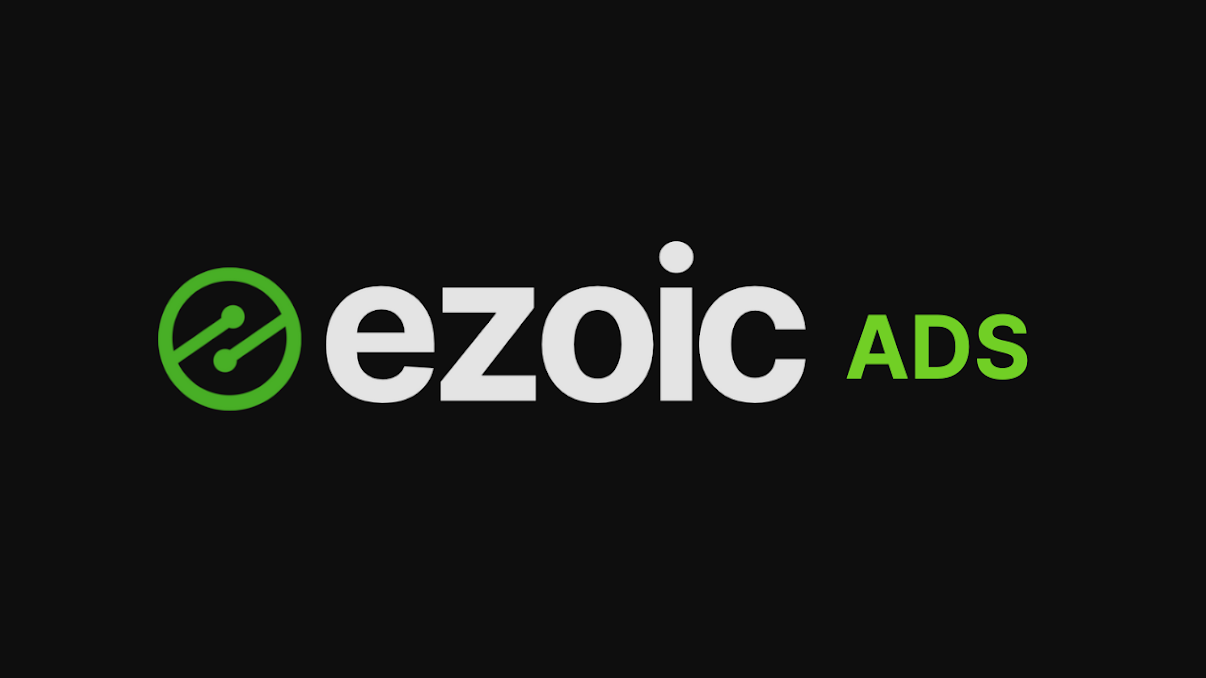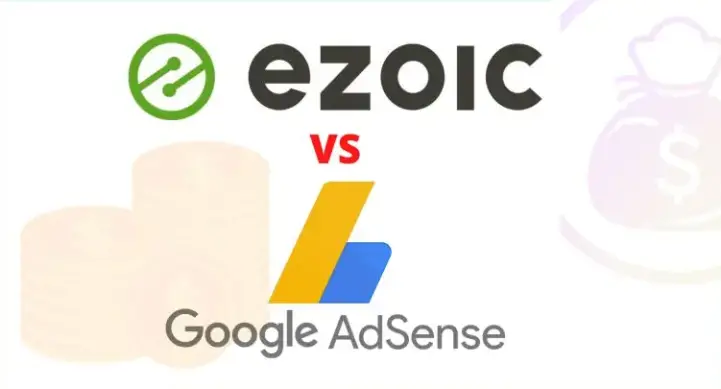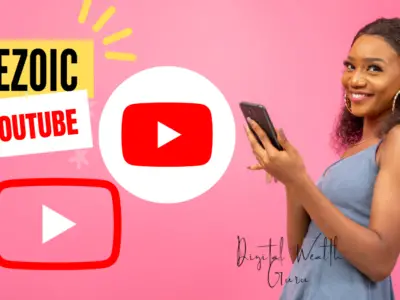Ezoic vs AdSense are two well-known advertising networks owners, publishers, and content producers utilize to monetize their online content. While their essential functions are identical, the two have 30 significant variations.
The digital landscape is teeming with opportunities for website owners to generate revenue through advertising. Two titans, Ezoic and AdSense, dominate the ad network arena, each offering distinct advantages and drawbacks. Let’s unravel their complexities and see which might be your golden ticket to monetization success.
AdSense is an advertising service owned by Google that enables website owners or content providers to show customized adverts on their websites. It has an easy-to-use interface and access to a large network of advertisers, making it simple for publishers to begin monetizing their content.
AdSense employs contextual targeting, which examines a site’s content to deliver appropriate advertising. It provides a variety of ad forms, such as text, display, video, and mobile advertisements.
Ezoic, on the other hand, is an AI-powered platform that aims to optimize website revenue and user experience simultaneously. It uses machine learning algorithms to test and analyze different ad placements, sizes, and configurations to find the optimal combination that generates the highest revenue.
Ezoic offers additional features like site speed optimization, automated ad testing, and visitor segmentation.
Ezoic vs AdSense: The Ultimate Guide for Bloggers & Publishers
Here’s a breakdown of Ezoic vs. AdSense, focusing on additional nuances and considerations:
AdSense: The Grandfather of Ad Networks
Born from the tech giant Google, AdSense has become synonymous with website monetization. Its widespread adoption stems from its user-friendly interface, reliable payment system, and lack of minimum traffic requirements. Essentially, it allows website owners to display ads relevant to their content and audience, earning revenue through clicks or impressions.
- Wide Reach: As Google’s display ad network, AdSense boasts access to a massive pool of advertisers. This ensures ads are almost always available to fill your space, even if they aren’t the highest-paying ones.
- Passive Income: Once you integrate AdSense code into your website, it runs independently. This makes it an excellent starting point for earning passive income without continuous optimization efforts.
- Limited Customization: Your control extends primarily to choosing where the general ad blocks appear. AdSense handles the specifics of which ads are displayed, their size, etc., often limiting earning potential.
- Beyond Simplicity: While AdSense is known for ease of use, it does offer some basic controls. You can block specific ad categories or URLs that don’t align with your content. Additionally, the AutoAds feature simplifies placement, though at the cost of customization.
- Good Starting Point: AdSense provides a baseline for website monetization. It’s a great way to learn how display advertising works and earn revenue while your site grows.
Pros of AdSense:
- Ease of Use: Even beginners can set up AdSense with minimal technical knowledge.
- Accessibility: Websites of all sizes, from fledgling blogs to large publications, can participate.
- Consistent Payments: Google’s payment system is known for its reliability and timeliness.
Cons of AdSense:
- Limited Optimization: The platform offers basic ad placement and format options, leaving potential revenue on the table.
- Lower Earning Potential: Compared to Ezoic, AdSense generally yields lower ad revenue due to its less sophisticated optimization algorithms.
- Generic Support: While there’s a vast online forum, personalized support can be lacking.
Ezoic: The AI-Powered Ad Revenue Booster
Ezoic, a certified Google Publishing Partner, takes ad optimization to new heights. Its AI-driven platform tirelessly tests various ad placements, sizes, and formats to pinpoint the most effective combinations for your specific audience and content. This continuous optimization translates into higher ad revenue and a better user experience.
- Machine Learning Advantage: Ezoic’s most significant edge lies in its AI-driven optimization. It continuously tests thousands of ad combinations (placements, sizes, densities) on your site, tailoring the ad experience for each visitor. This results in a better user experience alongside higher revenue.
- Data-Driven Approach: Ezoic’s core strength is constantly analyzing site performance, visitor behaviour, and advertising market trends. This allows them to tailor ad combinations that maximize your revenue for every session.
- Big Data Benefits: Their AI system processes massive amounts of data beyond what you can manage manually. This means their optimization often outperforms individual tweaks you might try.
- Site Health: Ezoic prioritizes balancing revenue with a positive user experience. They offer tools to optimize site speed, layout, and other factors influencing visitor satisfaction and search engine rankings.
- Ezoic Premium: Ezoic offers higher-tier subscription plans that give publishers access to top-performing ad partners and features. This can lead to even better returns.
- Beyond Basic Ads: Ezoic provides access to premium features like header bidding, video ads, ad mediation, and more. These can further boost your revenue potential but may come with additional setup or subscription costs.
Pros of Ezoic:
- Maximized Revenue: Ezoic consistently outperforms AdSense in terms of ad earnings.
- Advanced Features: Beyond ad optimization, Ezoic offers tools for site speed improvement, layout testing, and more.
- Personalized Support: Publishers get dedicated account managers who provide tailored guidance and assistance.
Cons of Ezoic:
- Traffic Requirements: To unlock Ezoic’s full potential, you’ll need at least 10,000 monthly visitors.
- Learning Curve: The platform’s numerous features and customization options may require some initial effort to master.
30 Overlooked Facts About Ezoic and AdSense That Could Change Your Earnings

Here are the 30 overlooked facts about Ezoic and AdSense:
- Optimization: Ezoic focuses on optimizing ad placements and configurations to maximize revenue, while AdSense provides ads based on contextual targeting.
- Control: AdSense gives you more control over the ads that appear on your site, allowing you to block certain categories or specific ads. Ezoic also provides control but emphasizes automated optimization.
- Testing: Ezoic’s machine learning algorithms test different ad configurations to find the best-performing ones, while AdSense relies on the website owner to manually optimize ad placements.
- Eligibility: AdSense has a relatively straightforward application process, and many websites can be approved quickly. Ezoic had certain requirements, including a minimum traffic threshold for publishers to join their platform, but that threshold was recently lifted to give new publishers the same opportunity.
- Revenue Split: AdSense operates on a revenue-sharing model, where publishers typically receive a percentage of the revenue generated by the ads. Ezoic offers a subscription-based pricing model or a revenue share option, depending on the publisher’s preference.
- Revenue Potential: Ezoic claims to increase ad revenue for publishers by leveraging its optimization algorithms. Some publishers have reported significant revenue growth after switching to Ezoic. However, AdSense has a vast network of advertisers, sometimes resulting in higher bidding competition and potentially higher revenue.
- User Experience: Ezoic strongly emphasizes improving user experience alongside ad revenue optimization. They offer features like site speed optimization and visitor segmentation to enhance the overall user experience on your website. AdSense, while it does provide some ad customization options, does not have the same level of focus on user experience.
- Support and Resources: AdSense benefits from being a Google product and has a robust support system, including documentation, forums, and a help centre. Ezoic also offers support resources, but it may not be as extensive as AdSense due to its smaller user base.
- Ad Network: AdSense allows you to tap into Google’s extensive ad network, which includes a wide range of advertisers from different industries. Ezoic also has its own ad network, but it may not be as extensive or diverse as the Google Ads network.
- Website Requirements: AdSense has relatively fewer requirements for website eligibility, and it can be used on various types of websites, including blogs, news sites, and niche websites. Ezoic has some requirements you must meet, and certain types of websites, like E-Commerce, may not be eligible to join their platform.
- Ad Quality: AdSense has strict policies in place to ensure the quality of ads displayed on websites. Google’s ad review process helps filter out low-quality or inappropriate ads, which helps maintain a positive user experience. Ezoic also has ad quality control measures in place but may not have the same level of scrutiny as AdSense.
- A/B Testing: Ezoic offers advanced A/B testing capabilities, allowing you to compare different versions of your website and ad configurations to determine which ones perform better in revenue and user experience. AdSense does not provide built-in A/B testing functionality, so you must implement and track tests separately.
- Ad Layout Control: Ezoic provides granular control over ad layout options, allowing you to customize the placement, size, and appearance of ads on your website. AdSense also provides customization options, but the control level may not be as extensive as Ezoic.
- Payment Options: AdSense offers various payment options, including bank transfers, checks, and Western Union, depending on your location. Ezoic provides payments through direct deposit or PayPal.
- Data Ownership: With AdSense, you maintain ownership of your website’s data. Ezoic operates under a data partnership model, which means they use aggregated and anonymized data from participating websites to improve their algorithms and provide insights to publishers.
- Experimentation and Innovation: Ezoic often introduces new features and technologies to improve website monetization. They actively engage with publishers and gather feedback to enhance their platform. Being a part of Google, AdSense also regularly updates its offerings but may not focus as specifically on website monetization as Ezoic.
- Website Speed: Ezoic offers site speed optimization features, including automatic image optimization and caching, to improve the loading times of your web pages. AdSense does not provide specific site speed optimization features, although optimizing your website’s performance generally benefits user experience and ad revenue.
- Ad Blocker Recovery: Ezoic has a feature called Ad Blocker Recovery that attempts to recover revenue from visitors who have ad blockers enabled. It displays alternative ad formats or messaging to encourage users to disable their ad blockers. AdSense does not provide a built-in ad blocker recovery feature.
- Reporting and Analytics: Ezoic and AdSense offer reporting and analytics tools to track your ad performance, revenue, and user engagement. However, the level of detail and the presentation of data may differ between the two platforms. It’s important to assess which reporting features are most important to you and evaluate how each platform meets your requirements.
- Third-Party Integrations: AdSense integrates well with other Google products and services, such as Google Analytics, allowing you to access comprehensive insights about your website traffic and ad performance. Ezoic also provides integrations with third-party tools and platforms, but the range of integrations may not be as extensive as AdSense.
- Multilingual Support: AdSense supports multiple languages and can display ads in various languages based on the user’s location and preferences. Ezoic also offers multilingual support, allowing you to monetize your content in different languages.
- Control Over Advertisers: AdSense provides some control over the advertisers that appear on your website, allowing you to block specific URLs or categories. Ezoic, on the other hand, may provide limited control over individual advertisers. It primarily focuses on optimizing revenue through automated ad placement optimization.
- Platform Stability: AdSense has been a well-established and widely-used platform for many years, offering stability and reliability. Ezoic, while growing in popularity, is a relatively newer platform and may not have the same level of long-standing reputation and stability as AdSense.
- Eligibility for Multiple Platforms: Ezoic allows publishers to work with multiple ad networks simultaneously, including AdSense. You can use Ezoic alongside AdSense to maximize your revenue potential by leveraging both platforms. AdSense, however, does not permit the simultaneous use of other ad networks.
- Control Over Ad Density: Ezoic controls the density of ads displayed on your website, allowing you to adjust the number of ads shown to your visitors. Conversely, AdSense automatically optimizes ad density based on factors like page layout and user experience guidelines.
- Website Testing and Development: Ezoic offers features beyond ad optimization, such as website testing and development tools. This can be useful if you’re looking to experiment with different website layouts, designs, or functionality. AdSense primarily focuses on ad monetization and does not provide extensive website testing and development capabilities.
- Pricing: AdSense is free to join, and publishers earn revenue through a revenue-sharing model. Ezoic offers a free plan but has premium subscription plans with additional features and benefits. The pricing structure for Ezoic varies based on factors such as website traffic and the level of service you require.
- Customer Support: AdSense offers customer support through various channels, including email, forums, and a dedicated help centre. Ezoic also provides customer support, but the level of support and response times may differ between the platforms. It’s important to evaluate the quality and availability of customer support when choosing a platform.
- Ad Format Support: AdSense supports various ad formats, including text, display, video, and mobile ads. Ezoic supports these formats but may have additional formats or placements available for testing and optimization.
- Ad Viewability: Ezoic strongly emphasizes ad viewability, aiming to optimize ad placements for maximum visibility and engagement. They provide tools and insights to help you understand the viewability of your ads. AdSense also encourages ad viewability but may not have the same level of focus or dedicated tools for optimizing this aspect.
My Person Experience: With Ezoic and AdSense

In my experience as a website owner, I have had the opportunity to compare Ezoic and AdSense to monetize my online content. Let me share my personal perspective and anecdotes on these platforms:
When I first started monetizing my website, I opted for AdSense due to its reputation and ease of use.
The setup process was straightforward, and I quickly started displaying targeted ads on my site. AdSense provided me with a user-friendly interface and access to a wide network of advertisers. Seeing the revenue trickle in as visitors engaged with the ads was exciting.
However, as my website grew and I delved deeper into revenue optimization, I discovered Ezoic. Ezoic’s AI-powered optimization intrigued me, and I decided to try it.
The platform’s machine learning algorithms continuously tested different ad placements, sizes, and configurations to find the optimal combination that maximized revenue. Seeing how Ezoic dynamically adjusted the ad layout based on user behaviour and preferences was impressive.
One aspect that stood out was Ezoic’s focus on user experience. They offered features like site speed optimization, which significantly improved the loading times of my web pages. Additionally, Ezoic’s Ad Blocker Recovery feature helped me recover revenue from visitors with ad blockers enabled, mitigating potential losses.
Although AdSense allowed me more control over the types of ads displayed on my website, Ezoic’s automated optimization proved to be a game-changer. It took the guesswork out of ad placement and configurations, allowing me to focus on creating quality content while Ezoic worked its magic behind the scenes.
Furthermore, Ezoic’s A/B testing capabilities empowered me to experiment with different versions of my website and ad configurations. This helped me identify the best-performing combinations that generated revenue and enhanced the overall user experience.
On the flip side, AdSense had the advantage of being a well-established platform with a vast network of advertisers. This often resulted in higher bidding competition and potentially higher revenue.
Additionally, AdSense integrated seamlessly with other Google products, such as Google Analytics, providing comprehensive insights into website traffic and ad performance.
Regarding support, AdSense’s extensive documentation and help centre were valuable resources. However, Ezoic’s support, although not as extensive, provided personalized assistance and was responsive to my inquiries.
Ultimately, my goals and priorities drove my choice between Ezoic and AdSense. Ezoic’s focus on revenue optimization and user experience, coupled with its advanced features like automated testing and optimization, made it my preferred choice. However, I also recognized the benefits of AdSense’s extensive ad network and integration with other Google tools.
In conclusion, both Ezoic and AdSense have their strengths and weaknesses. As a website owner, assessing your needs, revenue goals, and user experience priorities is crucial before deciding. It might even be worth considering combining both platforms to leverage their advantages.
Ezoic vs AdSense: Factors Influencing Your Choice

Here’s a deeper dive into the factors that should influence your decision between Ezoic and AdSense:
1. Website Traffic Levels:
- Low Traffic: AdSense might be the safer starting point if your website gets very little traffic (under 10,000 monthly pageviews). Setting up is simpler, and you generally won’t run into approval issues.
- Moderate to High Traffic: Ezoic’s potential starts to shine with more established sites. With greater traffic volume, their sophisticated optimization tools can make a bigger difference in revenue, outweighing AdSense’s simplicity. While Ezoic has minimum traffic requirements, some exceptions are made based on your niche and overall potential.
2. Technical Expertise:
- Beginner: AdSense is incredibly user-friendly. Simply add a code snippet, and AdSense handles the rest. It’s good if you’re uncomfortable with complex website tweaks.
- Intermediate to Advanced: Ezoic involves implementing code and potentially DNS changes for their AI optimization to work its magic. It may require some technical know-how or willingness to learn.
3. Content Type and Layout:
- Highly standardized content: If your site has a straightforward layout (e.g., traditional blog format), AdSense can work well. Their algorithm effectively places ads in a non-intrusive manner on standardized pages.
- Unique/Dynamic Layouts: If your website experiments with content types, unusual sections, or interactive elements, Ezoic’s customization options offer more flexibility in ad placement for optimal results.
4. Earning Potential vs. Control:
- Priority on Control: If knowing exactly where your ads will appear is crucial, AdSense offers more predictable placement.
- Priority on Revenue: If you’re willing to give up some control for the chance of significantly higher ad income, Ezoic’s machine-learning optimization offers that potential.
5. Time Investment:
- Limited Time: AdSense is close to “set it and forget it”. Perfect if you’re short on bandwidth and want quick monetization.
- Willing to Invest: Ezoic’s setup can be a bit more involved, and their platform offers the tools to truly optimize over time. If you’re ready to put in some effort to maximize earnings in the long run, Ezoic is worth considering.
Remember: These factors are guidelines, and you’ll want to weigh what’s most important to you in the context of your specific website.
Questions to Ask Yourself:
- How much time am I willing to dedicate to ad optimization?
- Do I want detailed data and control or something that works in the background?
- Is maximizing revenue my primary goal, even if the setup is more complex?
Why is AdSense better than Ezoic?
Ultimately, choosing Ezoic and AdSense depends on your needs and goals. AdSense is suitable for beginners or those who prefer more control over ad placement and targeting.
Ezoic, with its AI-powered optimization and additional features, maybe a better fit for those looking to maximize revenue and improve user experience through automated testing and optimization.
Can I use Ezoic with AdSense?
Yes, you can use Ezoic and AdSense together. Ezoic allows publishers to work with multiple ad networks simultaneously, including AdSense. You can use Ezoic’s optimization and revenue maximization features alongside AdSense to diversify your ad monetization strategy and potentially increase your revenue.
1. Intergrating Ezoic and Google AdSense
By integrating Ezoic with AdSense, you can use Ezoic’s AI-powered optimization algorithms to test and analyze different ad placements, sizes, and configurations. This can help you find the optimal combination that generates the highest revenue for your website.
2. Benefits of using Ezoic and Google AdSense
Using both Ezoic and AdSense together allows you to leverage the strengths of each platform. AdSense provides access to Google’s extensive ad network, while Ezoic optimizes ad placements and configurations to maximize revenue.
It’s important to note that you’ll need to follow the policies and guidelines of both platforms when using them simultaneously.
3. How To Use Ezoic and Google AdSense
To use Ezoic with AdSense, you would typically sign up for an Ezoic account, go through their setup process, and connect your AdSense account to Ezoic. Ezoic provides guidance and support throughout the integration process to ensure smooth operation.
Multiple ad networks can provide more flexibility, diversify your revenue streams, and potentially increase your earnings. However, it’s essential to monitor and analyze the performance of each network to ensure they work well together and don’t negatively impact user experience.
How Much Does Ezoic Pay Per 1,000 Page Views?

Ezoic pays $10 to $50 per 1,000 page views depending on multiple factors that form a specific rate for specific content creators. The specific payment rates for Ezoic can vary based on multiple factors, including the website’s niche, traffic quality, ad placement, and the ad networks involved.
In contrast to Google AdSense, where you receive payment for each click, Ezoic compensates you for every instance an ad is viewed by a reader on your website. Your earnings are calculated based on EPVM (earnings per thousand visitors), indicating the amount of money you earn for every 1,000 visits to your site.
Ezoic Requirements
Here’s a breakdown of Ezoic’s requirements and things to keep in mind:
Ezoic General Requirements
- Google Policy Compliance: Your website MUST adhere to Google’s AdSense policies. This includes no illegal content, misleading content, invalid/manipulated clicks, aggressive or harmful advertising, etc.
- Original Content: Your site must primarily provide unique and valuable content, not scraped or heavily duplicated material.
- Traffic Sources: While there’s no strict traffic minimum, Ezoic favours sites with primarily organic traffic (from search engines).
Ezoic Access Now (For Smaller Sites)
Ezoic’s “Access Now” program is designed to accommodate smaller publishers:
- Traffic: No specific minimum is mentioned, but sites benefit more with 10,000+ monthly pageviews.
- Additional Considerations: If traffic is lower, Ezoic will consider other factors, such as content quality, site layout, and user experience.
Ezoic Premium
Ezoic’s Premium tier requires an invitation and offers access to exclusive ad partners and potential even higher earnings. Their general guidelines for Premium invite include:
- Traffic: An established base of at least 20,000 monthly visitors
- Revenue: Consistent ad revenue (a good indicator of quality traffic)
Important Notes:
- Approval Isn’t Guaranteed: Meeting the requirements doesn’t automatically lead to acceptance. Ezoic assesses sites individually for overall quality and suitability for their platform.
- Google MCM Approval: All sites using Ezoic need approval for Google’s Multiple Customer Management (MCM) program, which can take 1-2 weeks.
For the most up-to-date and official requirements and processes, always refer to Ezoic’s website: https://www.ezoic.com/faq/
AdSense Requirements
Here’s a detailed breakdown of Google AdSense requirements:
AdSense Eligibility
- Age Requirement: You must be 18 to create an AdSense account. A parent or guardian can apply using their own Google account if they’re younger.
- Ownership: You must own and control the website or platform you want to monetize with AdSense.
- Content: Your content must be original, high-quality, and provide value to users. It must also comply with Google’s AdSense Program Policies (more on these below).
AdSense Program Policies
Google takes these policies seriously to protect both advertisers and users. Key things to avoid include:
- Invalid Clicks/Impressions: You can’t artificially generate clicks or impressions or encourage users to click ads.
- Misleading Content: No content misrepresents products/services, conceals promotion, or is designed mainly to drive ad traffic.
- Illegal or Harmful Content: This includes things like promoting violence, sexually explicit material, illegal substances, or copyright infringement.
- Inappropriate Ad Placement: Don’t place ads that might be mistaken for regular content or encourage accidental clicks.
AdSense Technical Requirements
- Supported Languages: AdSense supports a wide range of languages. Check the official list to make sure yours is included.
- Site Navigation: Your website should be easy to navigate, with a clear structure.
- Traffic: While there’s technically no traffic minimum, having some traffic demonstrates your site has value for advertisers.
- Privacy Policy: Your site needs a clear privacy policy outlining how you handle user data.
Additional Notes
- Approval process: Google reviews all applications to ensure compliance with their policies. This process can take some time.
- Continuous compliance: Even after approval, Google monitors sites to ensure ongoing compliance with their policies.
For the most up-to-date information, refer to Google’s official AdSense documentation: https://support.google.com/adsense/answer/9724?hl=en
Ezoic Alternatives
Here’s a look at some top Ezoic alternatives, broken down by their strengths and who they might be suitable for:
1. Mediavine
- Requirements: Acceptance usually requires at least 50,000 sessions per month.
- Pros: Known for quality advertisers, excellent customer support, and various lifestyle-focused content tools.
- Best for: Established bloggers and content creators in the lifestyle, food, travel, DIY, and parenting niches with good-quality traffic.
2. AdThrive
- Requirements: Focuses on high-quality sites, at least 100,000 monthly pageviews.
- Pros: Excellent reputation, high RPMs (Revenue Per Mille/Thousand Impressions), hands-on support.
- Best for: Larger websites that produce consistent quality content and attract a primarily US-based audience.
3. MonetizeMore
- Requirements: Less strict traffic requirements, making them accessible to mid-size websites.
- Pros: Header bidding technology, detailed reporting, and ad optimization assistance.
- Best for: Publishers open to testing different ad formats and focusing heavily on revenue maximization.
4. Google AdSense
- Requirements: None. Easy to get started, even for smaller sites.
- Pros: Massive advertiser pool, easy setup, seamless integration with other Google tools.
- Best for: Beginners, those seeking a basic passive income stream, or for sites where granular control over advertising isn’t the highest priority.
5. Newor Media
- Requirements: More flexible traffic minimums.
- Pros: Focus on good user experience (UX), provides site speed solutions, and caters to various niches.
- Best for: Those worried about ads harming the user experience on their website and for publishers across a range of niches.
Additional Alternatives Worth Considering
- Publift: Offers ad layout optimization and revenue analytics tools.
- Infolinks: Provides unique ad units such as in-text links.
- AdPushup: A/B testing and optimization tools for publishers.
Important: No single solution is the absolute “best”. The right alternative for you depends heavily on your site’s niche, audience, traffic volume, and your own technical expertise and revenue goals.tunesharemore_vert
Ezoic vs AdSense Comparison

Here’s a tabular comparison of Ezoic vs. AdSense:
| Feature | Ezoic | AdSense |
|---|---|---|
| Technology | AI-powered ad optimization | Basic ad optimization |
| Earning Potential | Generally higher due to continuous optimization | Generally lower |
| Ad Placement | Dynamic, AI-driven testing | Manual placement |
| Minimum Traffic | 10,000 monthly pageviews | No minimum requirement |
| Ease of Use | Requires some technical knowledge, but has dedicated support | User-friendly, easy setup |
| Additional Features | Site speed accelerator, layout tester, and more | Limited additional features |
| Support | Personalized account management | Generic online forums and resources |
| Revenue Share | Flexible, ad-funded or revenue share options | Fixed revenue share |
| Best For | Established sites with significant traffic | New websites or those with less traffic |
Key Takeaways:
- Ezoic excels in maximizing ad revenue through its advanced AI optimization, making it ideal for larger websites.
- AdSense is a straightforward option for beginners or smaller sites that don’t meet Ezoic’s traffic requirements.
- Ultimately, the best choice depends on your specific needs, traffic levels, and technical comfort.
The Verdict: Ezoic vs AdSense
The Ezoic vs. AdSense debate ultimately comes down to your individual needs and priorities. There’s no single “best” platform for everyone. New websites might find AdSense’s simplicity appealing, while established sites with significant traffic may unlock a wealth of potential with Ezoic.
The key is to thoroughly assess your goals, resources, and technical comfort level. Whether you choose to start with AdSense and graduate to Ezoic or dive straight into Ezoic’s advanced features, remember that website monetization is an ongoing process. Continuous testing, optimization, and adaptation are essential for long-term success.
Discover more from Digital Wealth Guru
Subscribe to get the latest posts sent to your email.










Hi there just wanted to give you a quick heads up. The words in your content
seem to be running off the screen in Firefox. I’m not sure if this is a formatting
issue or something to do with internet browser compatibility but I figured I’d post to let you
know. The layout look great though! Hope you get the issue resolved soon. Thanks
Thank you for bringing this to our attention! We appreciate your heads up about the formatting issue in Firefox. It’s important for us to ensure that our content is accessible to everyone, regardless of the browser they use. Our team will investigate the problem right away and work on resolving it promptly.
We’re glad to hear that you like the layout otherwise! Your feedback is valuable to us, and we aim to provide the best possible user experience. If you have any more suggestions or encounter any other issues, please feel free to let us know.
Thanks again for taking the time to reach out and for your understanding.